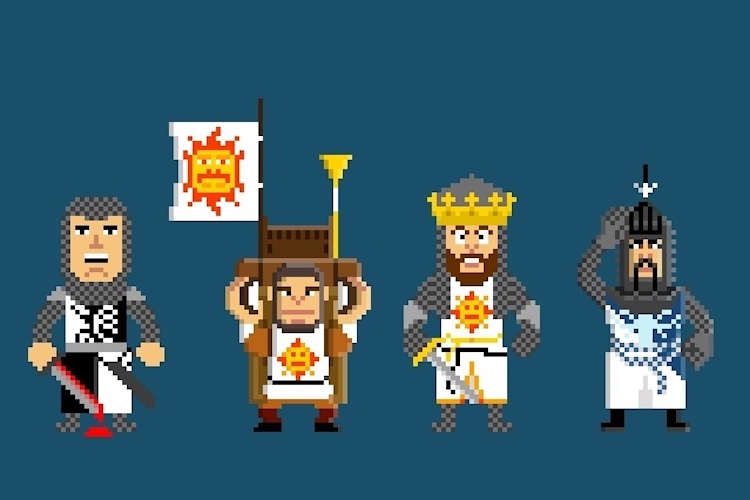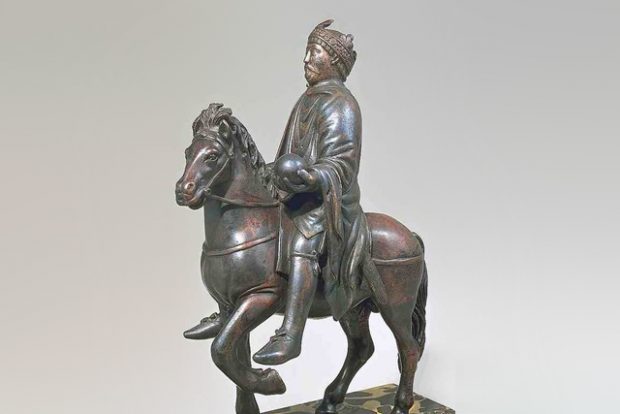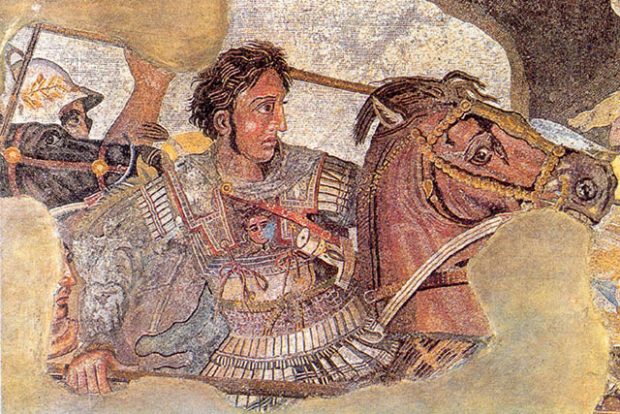Student Life in the Medieval Universities
Historian Peter Jones on the seven liberal arts, first textbooks and drinking as part of the student culture

According to legend, King Arthur was a Briton leader during the fifth or sixth century. However, the Arthur figure as we know it is most likely a composite figure, the conflation of several persons, real or imagined. Once established, the legend grew by accretion, with new stories attached to it at every turn. Efforts to identify the person or persons behind the legend have been numerous, and many of those attempts are unconvincing. A number of them lead to a breathless announcement that the “real Arthur” has been found, but only some of these investigations are the result of serious scholarship.
Legend identifies Arthur as the leader of the Britons during the fifth or sixth century. His prowess in battle led him eventually to be taken as a major figure in the ultimate victory over Saxon enemies who invaded Britain following the Roman withdrawal in A.D. 410. In the sixth century, a monk named Gildas produced a book that purported to give an account of events involving the Saxon and Briton wars. He makes no mention of Arthur, but he writes of the battle of Mount Badon, a significant mention because that battle was later associated with Arthur. Gildas also offers the story of a leader, later identified as Vortigern, who will be a prominent character in the story of Arthur.
The first relatively full (albeit fictional) biography of Arthur comes some three centuries after Nennius. It is the History of the Kings of Britain, composed in Latin by Geoffrey of Monmouth in or around 1137. Many of the details will be familiar to readers who primarily know Arthurian stories presented by modern authors. In Geoffrey’s version, we have the story of Arthur’s conception and birth, the result of Uther Pendragon’s love for Ygerna, a married woman; he is transformed (by Merlin, who plays a prominent role in Geoffrey’s work) into the likeness of the woman’s husband and sleeps with her.
The young Arthur becomes king and, with the help of a wondrous sword, Caliburnus (Excalibur), wins victories over the invading Saxons. Twelve years of peace follow, during which Arthur founds a distinguished order of knighthood and also marries Guinevere. Geoffrey also relates the treason of Mordred and his battle with Arthur, who is grievously injured and taken away to the Isle of Avalon. Geoffrey makes no pronouncement concerning Arthur’s possible return to the world.
Following Geoffrey of Monmouth, a writer named Wace adapted a part of Geoffrey’s text into French, adding many details and quoting—that is, inventing—conversations and anecdotes. In the process, he added one of the major motifs of the legend: the Round Table.
Beginning in the last half of the twelfth century, French authors drew inspiration from prior stories of Arthur and offered original accounts of the king. Foremost among these writers was Chrétien de Troyes, whose five Arthurian romances developed a code of chivalry and love and also gave us the name Camelot, the adulterous love of Lancelot and Guinevere, and the Grail Quest. However, instead of biographical detail, Chrétien and many other authors chose to concentrate on a restricted time frame and present episodes from the lives of one or several knights, though rarely of Arthur himself. According to these legends, the King’s fame and the prestige of his court attracted knights from distant lands.

French authors of the following century drew on the earlier works to compose long and detailed romances, many of which were combined to create huge cycles. One of them, the so-called Vulgate Cycle, offers a kind of universal history beginning with the time of the Crucifixion but concentrating on the life of Arthur, including the adventures of many of his knights. This cycle incorporates familiar motifs and characters, such as the Round Table fellowship, Merlin, the fatal love of Lancelot and Guinevere, and Mordred’s treason. A prominent portion of the cycle focuses on the Grail Quest, in which Galahad, the purest of the knights, is the only knight able to succeed.
That cycle was the foremost among a number of sources used by Sir Thomas Malory, whose English Morte Darthur (‘Death of Arthur’), completed in 1470, quickly became, and has remained, the most influential of all Arthurian creations. Malory reordered material borrowed from his sources and modified the tone and often the content of episodes, offering us an account running from Arthur’s conception and birth to his chivalric adventures and beyond. He remains noncommittal concerning Arthur’s possible return from Avalon, but he comments that some people predict it.
Accounts of Arthur’s life vary a great deal from one to another, but certain biographical elements recur in most texts (owing especially to the influence of Malory’s Morte Darthur) and can be taken as canonical. As the legend goes, Arthur was conceived when Merlin altered the appearance of Uther Pendragon, making him into the likeness of the husband of Ygerna, after whom Uther lusted. When Arthur was still a youth, there appeared before the church a large stone (or an anvil) with a sword embedded in it. An inscription indicated that the person able to withdraw the sword would be the king of England. Only Arthur succeeded.
As king, Arthur establishes the Round Table fellowship, and his knights seek adventure throughout the land. Arthur also marries Guinevere, and later she and Lancelot begin an illicit relationship. A quest for the Holy Grail is set into motion when Galahad, the predestined Grail knight, and Lancelot’s son, arrives at court. Most of the knights take part in the quest, and most fail and return to Camelot; only Galahad succeeds fully. Lancelot, who fails because of his sinful love for the queen, swears that he will renounce the affair, but as soon as he is back at court, his resolve weakens, and the lovers resume their sinful relationship.
There comes a time when the affair is discovered: Guinevere is imprisoned, but Lancelot escapes. He returns to save her, and in the ensuing battle, he kills Gawain’s brothers without recognizing them. Gawain, who is Arthur’s nephew, swears that he will avenge their deaths, and the result is a major war between Gawain’s army and Lancelot’s, with Arthur reluctantly required, by their kinship, to side with Gawain.
During the war Arthur has left his kingdom in the care of Mordred, his bastard son, but Mordred plots to assume the throne. He also wishes to marry Guinevere (and, in some texts, does so, usually against her will), but she manages to escape. Soon Mordred and Arthur meet in battle. Arthur kills his son but is critically wounded in the process. He is aboard a boat that comes ashore bearing a number of ladies, including Morgan. The boat sails away, and many accounts state, or hint, that Arthur will eventually return in the hour of Britain’s greatest need.
There was never a King Arthur. That much is clear. It is much less clear whether there was an Arthur or an “Arthur figure” who constituted the nucleus of the legend. Early Celtic legends were generally limited to the recording of a few folk beliefs about Arthur, and an early-twelfth-century author offers the first documented belief in Arthur’s destined return after his apparent death.

Serious historical study of the legend of Arthur required scholars to separate, insofar as possible, layers of folk belief from kernels of real events of the fifth and sixth centuries. The earliest references to Arthur consist of little more than lists (e.g., of battles) or brief anecdotes, and even extended accounts, such as Geoffrey of Monmouth’s, are a blend of history, folk tradition, and authorial invention.
The scholarly study of Arthur began in earnest in the early twentieth century and initially concentrated on the list of Arthur’s battles and his resistance to the Saxon invaders. R.G. Collingwood suggested that this dux bellorum was a leader of the cavalry. Kenneth Jackson studied some of the battle sites and argued that Arthur might have, in fact, been a warrior named Artorius who ranged rather far afield for military purposes but was probably based in the southwest. Other scholars argued for a northern Arthur. Geoffrey Ashe has identified a certain Riothamus (not a name but an honorific meaning “supreme king”) as an important Arthur figure. Riothamus, in fact, is called “King Arthur” in an early-eleventh-century text. This Riothamus led an army across the Channel and did battle in Gaul (France).
These and other serious efforts have not stopped numerous people, with or without scholarly credentials, from announcing that “the real Arthur” or the real Grail has been, at last, discovered. In reality, Arthur, as we know him, may well be a conflation of several leaders. Alternatively, there may have been a single person to whom any number of epic events were attributed. And it is by no means certain that a particular Arthur figure even existed; he may have been created out of whole cloth.
Serious scholarly study of the legend often focuses on places such as Glastonbury, Tintagel, and Cadbury Castle. The last of these has provoked interest since at least the sixteenth century. The term “castle” in regard to the early British period refers simply to a fortified hill, and the most remarkable of them was Cadbury. Excavations at these and other places tell us nothing about the king himself but can reveal a great deal about life as “Arthur” would have known it.

The Arthurian characters who may be representations of historical personages include Mordred and Bedevere, who are mentioned in some of the earliest texts about Arthur, and also, surprisingly, Merlin, who might be a fusion of two early figures. Lancelot, Guinevere, and most, if not all, of the others are entirely fictional creations. Arthur himself is a special case. That we cannot, with confidence, identify a historical Arthur does not prevent regular efforts to do so. Frequent books, articles, and journalistic announcements inform us that the king has at last been identified. Few such claims are credible, but they continue.
Because there was never a “King Arthur” per se, the best we can do is talk of an “Arthur figure,” a person of some renown who had additional feats, real or invented, attributed to him. Among such persons thought to be the model for Arthur, two stand out. The first, initially suggested by Kemp Malone in 1924, is Lucius Artorius Castus, a Roman soldier. Presumably a leader of equestrian troops, he lived in the second century A.D. and distinguished himself militarily. Very little is actually known about him, but in the absence of evidence, a good many pertinent events at the time may well have been attributed to him.
Geoffrey Ashe has proposed an alternative theory. His argument, mentioned above, concerns Riothamus, who is known to have led an army across the channel. What makes him an even more compelling candidate for the role of Arthur is that the last mention of him occurs when he nears the Burgundian village with the strikingly “Arthurian” name Avallon.

However the legend began, and whether or not a particular person stands behind it, it grew and flourished as layers and layers of pure fiction, mixed, perhaps, with some historical or biographical material, were added to it.
The popularity of the Arthurian legend waned but never disappeared from the sixteenth through the eighteenth century. It regained its popularity and currency during the nineteenth century, especially in anglophone countries. There are certain elements of the Arthurian legend that have generally retained their meaning and resonances since the Middle Ages. These include Camelot, the Sword in the Stone (or Anvil), the adulterous love of Lancelot and Guinevere, and the Round Table. Arthur’s possible survival and return are motifs about which most early authors were noncommittal; Malory tells us that “some people” say that Arthur will return but that he, Malory, cannot say. The belief in Arthur’s return has occasionally been seriously entertained through the centuries, and some modern novelists have taken his return as the subject of their stories.

The Grail Quest is an important exception to the list of motifs whose meaning remains relatively constant. In the medieval legends, the Grail Quest is a success for Galahad, the purest knight, but a disaster for most of the others, who are killed during the Quest or, like Lancelot, must return to court as failures. The ranks of Camelot’s knights are largely decimated, and chivalric excellence is shown to be incompatible with the requisite spirituality of the Grail Quest. Over time, this incompatibility was often dissolved so that a number of Arthurian novels and films, such as John Boorman’s Excalibur, actually had Arthur lead the Quest.
The Grail proves to be a malleable motif. Initially a marvelous but holy tray (in Chrétien de Troyes), it was soon transmuted into the dish or chalice of the Last Supper. In German, Wolfram von Eschenbach presents it as a stone fallen from heaven. Many authors of the twentieth and twenty-first centuries have modified it substantially. In Donald Barthelme’s The King, the Grail is a destructive bomb, and success is the decision not to use it. Elsewhere it can be made of paper, or it may not actually exist.
The major contribution to the legend in nineteenth-century England was doubtless Tennyson’s Idylls of the King, a poetic masterpiece that inspired authors and visual artists through that century and beyond. Entirely different in spirit is Mark Twain’s A Connecticut Yankee in King Arthur’s Court, an example of the humorous potential of the legend and also a brilliant condemnation of modern technology and its effect on life and attitudes. In England, the Preraphaelites, such as William Morris, Dante Gabriel Rossetti, and Edward Burne-Jones, created important Arthurian works in visual arts as well as literature. And yet another great nineteenth-century monument of Arthuriana is Richard Wagner’s Parsifal, an operatic setting of the Grail story.
The exploration of Arthurian themes in the twentieth century, comprising several thousand works, took very diverse forms, and it is impossible to single out just a few without omitting many dozens that merit recognition. Alongside retellings that represent a serious effort to remain faithful to the original legends, the Arthurian world has been recast as science fiction, murder mystery, feminist fiction, juvenile literature, and fantasy.
A few notable novels are the retellings by Mary Stewart (e.g., The Last Enchantment) and Rosemary Sutcliff’s Sword at Sunset; a retelling with strong comic overtones by Thomas Berger, titled Arthur Rex; T.H. White’s Once and Future King, which begins as a charming story but becomes a bitter anti-war document; and Marion Zimmer Bradley’s Mists of Avalon, considered a feminist novel. Phyllis Ann Karr’s The Idylls of the Queen recounts Sir Kay’s effort to solve a murder, whereas David Lodge uses Arthurian motifs in a clever academic novel, Small World. The legend is, of course, treated in forms other than novels, as witness T.S. Eliot’s Waste Land, an influential poetic treatment.
Outstanding modern treatments of Arthurian themes also occur in other languages, though far less frequently than in English. Examples include, in French, René Barjavel’s novel L’Enchanteur and, in German, Tankred Dorst’s drama Merlin oder das wüste Land. As for cinematic explorations of the legend, these include some films that are widely admired, such as John Boorman’s Excalibur and the zenith of comedic Arthuriana, Monty Python and the Holy Grail.
https://www.youtube.com/watch?v=dhRUe-gz690
The very number of Arthurian reinterpretations in the twentieth century and beyond raises a question: what can explain the continuing popularity of the legend, especially in anglophone cultures but also in France, Germany, Italy, and elsewhere? This is a question without a clear answer—or with multiple answers. Some readers may be interested primarily in Post-Roman British history, whereas the imagination of a good many people is stirred by the exoticism of a shadowy past. For many others, the notions of honor and social responsibility exert a powerful appeal, despite the fact that the early accounts include multiple examples of war, treason, rape, incest, and infidelity both to persons and to ideals. Whatever the reasons, the Arthurian story clearly has the power to inspire us even as we recognize the profound human failings everywhere apparent in the story of King Arthur.
Edited by Alina Shubina

Historian Peter Jones on the seven liberal arts, first textbooks and drinking as part of the student culture

Professor Mark Jarzombek on what Buddhist temples express, transfer of architectural techniques, and the Euroc...

David Dussault on human relationships, life experience and how to understand the influence that IT has on our ...